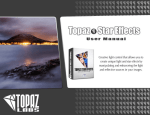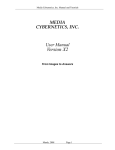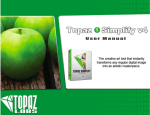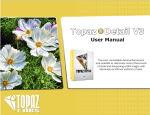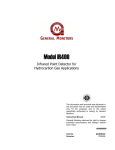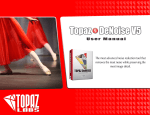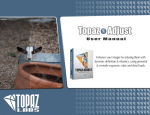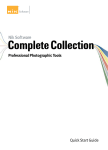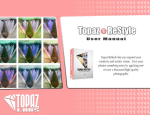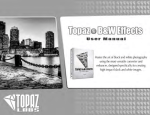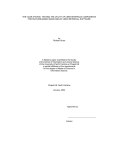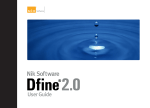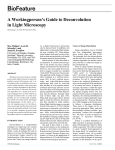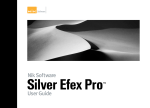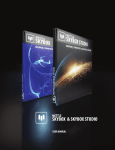Download Workflow - Topaz Labs
Transcript
Topaz InFocus User Manual I. Installation A. How to Install B. Entering Your Key C. Host-Specific Installation 1. Paint Shop Pro 2. Photo Impact 3. Irfanview 3 3 3 4 5 6 II. Introduction A. Sharpening 1. What is Sharpening? 2. Unsharp Mask 3. Deconvolution B. Topaz InFocus 1. About Topaz InFocus 2. Primary Functions of InFocus C. New InFocus Features 8 8 8 8 9 9 9 10 III. Work Area A. Interface B. Preview C. Presets 1. Applying Presets 2. Adding Presets 3. Deleting Presets 4. Importing Presets 5. Exporting Presets 6. Sharing Presets D. Tools E. Menu 1. Enter Key 2. What’s This? 3. User Guide 4. Tech Support 5. Product Info 13 17 19 19 19 20 21 21 21 22 23 24 24 24 24 24 6. My Topaz 7. Tutorials 8. About IV. Settings & Parameters A. DeBlur 1. Blur Type 2. Blur Radius 3. Motion Angle 4. Edge Softness 5. Suppress Artifacts B. Sharpen 1. Micro Contrast 2. Sharpness 3. Sharpness Radius 24 24 24 25 25 25 26 26 27 27 27 27 27 2 VI. Work Flow A. Sample Project #1 B. Sample Project #2 C. Sample Project #3 D. Sample Project #4 28 33 41 47 VII. Additional Resources A. Glossary B. FAQ’s C. Shortcut Keys D. Connect E. Company Info 52 54 57 58 59 Installation Topaz InFocus User Manual Topaz InFocus is a Photoshop plug-in, which means it won’t run by itself and requires a compatible host program. To Install 1. Close Photoshop or other image editing program if you are using it. 2. Open the Topaz InFocus dmg or zip file, double-click on the Topaz InFocus installer, and then follow the onscreen instructions. Mac Dmg Windows Zip 3. Your Topaz plug-ins will automatically be installed in your Photoshop plug-ins folder. 4. After the installation, you will need to enter your license or trial key. Important for Mac Users: After installation, Topaz InFocus will be installed in the following folder: “ Macintosh HD -> Library -> Application Support -> Topaz Labs -> InFocus”. If your Photoshop is installed in a customized location, you will need to manually create a shortcut (alias) link inside folder “<Photoshop install folder> -> Plug-ins” that links to “ Macintosh HD -> Library -> Application Support -> Topaz Labs -> InFocus -> Plug-ins”. Entering Your Key Entering your trial key allows you to save your projects and print them during your evaluation period. Entering your license key allows you do the same, except without any time limitations. 1. Start by opening up an image in Photoshop. 2. Go to Filters -> Topaz Labs -> InFocus -> Menu -> Enter key. 3. You can then copy and paste or type your key in. Important: To install the product on a second computer, you will need to download Topaz InFocus and then enter your same license key. Host-Specific Installation Topaz InFocus is also compatible with Lightroom, Aperture and iPhoto. To use InFocus in any of these programs you will need to download and install the free Topaz Fusion Express compatibility add on. You can get it online at: www.topazlabs.com/downloads In Windows, Topaz InFocus is supported by most host applications that support Photoshop plug-ins. This includes Paint Shop Pro, Photo Impact, Painter, and Irfanview, although there are additional host programs that may also support Topaz InFocus. To install InFocus in Paint Shop Pro, Photo Impact, or Irfanview, first download Topaz InFocus to the default location. Then, to configure InFocus into each program follow the host-specific instructions on the next page. 3 Topaz InFocus User Manual How to install Topaz InFocus in Paintshop Pro 1. First launch PaintShop Pro. Installation 3. Choose C: \ Program Files \ Topaz Labs \ Topaz InFocus plug-ins and click “OK”. 2. Go to Menu file -> Preferences -> File Locations. Select “Plug-ins” from the “File Types” list and click “Add”. 4 4. Topaz InFocus is now available to use. Simply go to Effects -> Plug-ins and select “Topaz InFocus”. Topaz InFocus User Manual How to install Topaz InFocus in Photo Impact 1. First launch Photo Impact. 2. Go to File -> Preferences -> General or use shortcut key F6. Installation Then click on the button and browse to find the InFocus plug-in folder located in: C: \ Program Files \Topaz Labs \ Topaz InFocus plug-ins and then click “OK”. 4. Restart Photo Impact. Go to Menu -> Effect to access plug-in. 3. Select Plug-ins from the Categories list. 5 Topaz InFocus User Manual How to install Topaz InFocus in Irfanview 1. Make sure that you have downloaded and installed the 8bf plug-in add-on, available on the Irfanview webpage. (http://www.software.com/irfanview-plugin) Installation 3. In the screen that pops up, select “Add 8BF filters” and navigate to the C: \ Program Files \ Topaz Labs \ Topaz InFocus \ Plug-ins folder and click “OK”. You will then see “Topaz InFocus” in the Available / Loadable 8BF Filters section. 6 2. Open Irfanview and go to Image -> Effects -> Adobe 8BF filters. 4. To use Topaz InFocus in the future, simply go to Image -> Effects> Adobe 8BF filters again and select “Topaz InFocus”. Topaz InFocus User Manual Uninstalling To uninstall Topaz InFocus follow these instructions: 3. Select Programs, then Uninstall a Program. Mac 1. Quit Photoshop (or other editing program). 4. Select Topaz InFocus and click remove. 2. Navigate to the Topaz Labs support files and frames located at: Macintosh HD -> Library -> Application Support -> Topaz Labs. Windows 7* 1. Quit Photoshop (or other editing program). 3. Locate the Topaz InFocus file and move it to the trash. You will need to enter your system password to OK this change. 4. Navigate to your Photoshop plug-ins folder located at: Applications -> Photoshop -> Plug-ins 5. Locate any leftover Topaz InFocus files and move it to the trash. Windows XP* 1. Quit Photoshop (or other editing program). 2. Click on the Start Menu and select Control Panel. 3. Double-click on Add / Remove programs. 4. Select Topaz InFocus and click remove. Windows Vista* 1. Quit Photoshop (or other editing program). 2. Click on the Start Menu and select Control Panel. 2. Click on the Start Menu and select Control Panel -> Programs -> Programs and Features. 3. Select Topaz InFocus and click uninstall. *Please note that if you also have the 64-bit version of InFocus installed, then you will need to first uninstall this version before you can uninstall the regular version. 7 Introduction Topaz InFocus User Manual Sharpening Original (well-focused) What is sharpening? Sharpening is the process of enhancing the apparent detail or sharpness of an image. While no new information is added to the image, sharpening will create an “optical illusion” of sharpness by boosting edge contrast, enhancing what is already in the image. Out-of-Focus Image Unsharp Mask One of the commonly used sharpening methods in digital image-processing is unsharp masking. Unsharp masking detects the edges within an image and increases the percieved sharpness by creating more drastic tonal transitions (contrast boost). Many times, this boost in edge contrast can produce a harsh unappealing look. Deconvolution In image processing, deconvolution is the process of approximately reversing the process that caused an image to be blurred. While unsharp masking increases the perceived sharpness of an image, deconvolution increases the actual sharpness based on information which describes some of the likely origins of the distortions when capturing the image. With deconvolution, “lost” image detail may be approximately recovered. This technology can be applied to both enhancing the clarity in an already well-focused image, as well as deblurring out-of-focus or motion blurred images. 8 Unsharp Mask Technology Note obvious contrast Deconvolution Technology (Topaz InFocus) Compare with Original! Introduction Topaz InFocus User Manual Topaz InFocus About Topaz InFocus Topaz InFocus uses the most recent image sharpening technology to provide unparralleled, intuitive detail refinement. It is the ultimate tool for superior sharpening, as well as de-blurring out-of-focus and motion blurred images. With Topaz InFocus, you gain tools to improve image clarity simply and effectively. Whether refining fine image features or rescuing a previously unusable out-offocus image, Topaz InFocus is the most advanced, yet user-friendly, solution to your sharpening needs. Using the most recent deconvolution technology, Topaz Infocus actually reverses the blurring process, allowing lost detail to essentially be recovered. Topaz InFocus offers you unprecedented de-blurring technology and fine detail enhancement for optimal results on every image. The Primary Functions of Topaz InFocus Include: 1. Sharpening and refining detail for a crisp and clear image. 2. Reverse image blur, recovering original image detail in both out-of-focus and motion-blurred images. Before Topaz InFocus 3. Restore true color and detail to image features obscured by natural haziness (caused by atmospheric effects). 4. Micro-contrast fine detail enhancement, used to enrich subtle structure features. To connect with other Topaz users, participate in Topaz contests and to see the latest tips, tricks and tutorials sign up for the new Topaz Forum online at: www.topazlabs.com/forum After Topaz InFocus 9 Topaz InFocus User Manual Introduction InFocus Features Topaz InFocus Features 1. DeBlur Tab. Multiple sliders included to control generic, out-of-focus and motion blur. 2. Sharpen Tab. Mulitple sliders included to control sharpening and micro-contrast detail enhancement. 3. Estimate Blur Button. Automatic estimation option for unknown or complex blur types. 4. Auto Updater. Get software updates instantly. 5. Snap / Recall buttons. Save up to 99 snapshot settings for comparison. Before Topaz InFocus 6. Undo / Redo buttons. 7. Collapsible side panels. Expand and collapse the preset and tool panel for an adjustable workspace. 8. Preset Enable / Disable option. Option to enable or disable the preset preview processing at program startup. 9. Preset Navigation. Use the up / down arrow keys to navigate the preset list and display the selected preset thumbnail (in preset preview window). Use the return (Enter) key to apply the currently selected preset. 10. Enable / Disable Tool Tips. Option to enable or disable the pop up tool tips. 11. Quick Slider Reset. Double click on the slider name to reset default slider values. After Topaz InFocus 10 Introduction Topaz InFocus User Manual 11 Before Topaz InFocus Introduction Topaz InFocus User Manual 12 After Topaz InFocus Work Area Topaz InFocus User Manual Interface (Main View) Although the Topaz InFocus interface may look intimidating at first glance, don’t worry: it’s actually quite simple and easy to use. You’ll soon be a pro after experimenting with it for a bit. In order to make sense of the function of each of the various controls, we have divided the interface into a few sections: 1 4 3 5 2 1. Presets Preview 2. Presets Panel 3. Preview Window 4. Preview Navigator 5. Settings & Parameters The removable preview window displays preset previews. Provides “snapshots” of pre-defined effects. Displays the preview of the original and adjusted image. Displays the region of the preview image you are currently focused on. Controls the editing using sliders to adjust the various effects. 13 Topaz InFocus User Manual Work Area Interface (Tool Panel View) Use the small white arrows to expand and collapse the preset panel. You can click the white arrow edge of the panel and drag it in or out. or grab the 14 Topaz InFocus User Manual Work Area Interface (No Panel View) Use the small white arrows to expand and collapse the preset and tool panels. You can click the white arrows or grab the edge of the panels and drag them in or out. 15 Topaz InFocus User Manual Work Area Interface (Preset Panel View) Use the small white arrows to expand and collapse the tool panel. You can click the white arrow edge of the panel and drag it in or out. or grab the 16 Work Area Topaz InFocus User Manual Preview Section The Preview section is the main window that is centered in the InFocus interface. The preview section shows you the original image and the processed preview of the image. Click on the image in the preview window (or use the Original and Preview buttons) to switch between the Original and Preview tabs and compare the filtered and un-filtered images. To pan the preview image, click and hold the left mouse button on the preview image and drag it around. When you let go of the mouse button, the new portion of the image will be processed and the result will be displayed. You can also use SPACE bar or your numbered shortcut keys “1” and “2” to switch back and forth between your filtered and unfiltered image in the preview window. 1 17 Work Area Topaz InFocus User Manual 18 You can zoom in or out of the preview image by clicking the “+”, or “-” buttons below the preview image. You can also resize the window as well by dragging the bottom right corner in and out. The “Ctrl +” and “Ctrl –” keys zoom in and out of the image, just like in Photoshop. You can use the arrow keys to adjust the value of the slider that is currently selected. A complete list of the shortcut keys can be found in the Shortcut Keys section later in this manual. Photoshop and other host software support many Image Modes, such as Grayscale, RGB, LAB, CMYK, etc. Images can also be 8, 16, or 32 bits per channel. Topaz InFocus supports both 8 bits per channel and 16 bits per channel. Topaz InFocus supports RGB mode only. To work on black-and-white images, first convert them to RGB mode. Work Area Topaz InFocus User Manual Presets 1 1. Presets Preview Presets are a great way to speed up and simplify the whole process of using Topaz InFocus. Presets are set previews with previously defined settings that you can recall and reapply at any time. The removable preview window displays preset previews. Click Hide / Show to expand or collapse the preset preview window at anytime during your workflow. We’ve included some default presets for you and, although they won’t work for every single photograph, they serve as excellent starting points for customized tweaking. Applying Presets Applying a default preset is easy and intuitive. Simply clicking on a preset will change all the settings in Topaz InFocus to match those in the selected preset. 2. Presets List 2 Lists all of the saved presets available for use. To get the exact results you want, you may still want to go through the tabs and tweak the parameters. Adding Presets Sometimes it’s convenient to be able to define presets and save your settings for later use. To do this, first adjust the Topaz InFocus parameters until you’re satisfied with the result. Then, click on “Save”. Remember that you can easily expand or collapse the presets panel by clicking on the small white arrow on the edge of the panel or by grabbing the panel edge and dragging it in or out. 3. Preset Options The preset options allow you to save your presets, delete presets (default presents cannot be deleted), import new presets and export your saved presets to share with your friends. 3 19 Topaz InFocus User Manual Work Area Then enter a preset name, select the type of image that it is good for and then enter a description and click “OK”. You can also select a second image category type that the preset is good for. Note that if the name you’ve entered is the same as a preset you’ve already defined then you will be asked if overwrite the previous one. Your preset will be automatically saved as a new file with a “.tpp” extension in the Topaz InFocus Presets menu and the preview is automatically generated. To apply it later, just click it like any other preset. Deleting Presets If you’d like to delete a preset the select the preset name and then click on Delete. Please Note: Default presents cannot be overridden or deleted. Once you delete a preset it or overwrite it when saving, then it cannot be retrieved. Saved presets are located in the Topaz InFocus “Presets” folder: C: \ Program Files \ Topaz Labs \ Topaz InFocus \ Presets unless you’ve opted to install Topaz InFocus into a different directory. Mac users have this folder at Macintosh HD / Library / ApplicationSupport /TopazLabs / InFocus / Presets. 20 Topaz InFocus User Manual Importing Presets To import a preset file, click the “Import” button. This will open up a “Browse” box to import a saved preset from your computer into Topaz InFocus. This is useful if you have downloaded a preset file that you’d like to use. Work Area Exporting Presets To export the preset file to a certain location, click “Export”. Name your preset and save it to your desktop or other specified location that you have reserved for saved presets. 21 You can then share this preset file with others who may then import it. Sharing Presets Feel free to share your saved presets by emailing them to your friends and having them put it into their Topaz InFocus Presets folder. Visit the Topaz Labs Blog which features the latest Photography, software and design information including tutorials, videos, and thoughts about both Topaz and non-Topaz topics. Work Area Topaz InFocus User Manual Tools 1 You will use the various tools in the tools panel during your workflow to make your image adjustments. 1. Preview Navigator - Displays the region of the preview image you are currently focused on. 2. Zoom Buttons - Use the zoom buttons to zoom in and out of your image. Or you can also set your image to fit the preview window or to view it at 100%. 3. Undo and Redo buttons. Snap and Recall buttons. Save up to 99 snapshot settings for comparison. 2 3 4 22 4. Sliders and Parameters - Controls the editing process using sliders to adjust the various effects. 5. Additional Slider Controls - Use the “Reset All” button to reset all of the sliders values back to zero. Note: The Estimate Blur button is only an option when the Unknown/Estimate blur type is chosen. In any other blur type is chosen, the Estmate Blur feature is not available. 5 Topaz InFocus User Manual Menu Work Area Check for Update Checks for available Topaz InFocus’ updates. You can access Topaz InFocus’s menu by clicking on the “Menu…” button at the bottom of the interface. 23 Click the Show Details button to get find out what’s included in the update before you install. Preferences Select this to enable or disable the program tool tips or the Auto-Update feature. Topaz InFocus User Manual Enter Key Select this to enter your trial or purchased license key. Work Area MyTopaz Brings you to the Topaz community where you can connect and interact with other Topaz users. Here you can also participate in discussions and contests, and share your favorite Topaz images. Tutorials Brings you to the Topaz InFocus tutorials page where you can access a variety of helpful video and text tutorials. You can also submit tutorials that you created here as well. About Select this to see what version of InFocus you currently have. What’s This? Select this (or click F1) then click on a feature in the Simplify interface to learn more about it. Users Guide Select it to pull up this user guide. Tech Support Brings you to the Topaz Labs support page where you can request assistance from our support specialists, contact our customer service team, retrieve lost license keys, or browse through our Knowledge Base. Product Info Select this to go to the Topaz InFocus web page to learn more about the Topaz InFocus plug-in. 24 Topaz InFocus User Manual Parameters Topaz InFocus has two settings tabs and a total of 6 parameters plus 4 blur types to help you achieve optimal image results. Settings & Parameters Blur Type There are three blur types to choose from: Generic (which is the primary type for sharpening needs), Outof-Focus, Straight Motion and Complex Unknown. Important Blur Type Tips: Deblur The Deblur tab includes the basic and most essential sharpening and deblurring tools. These tools are the main ones that you will use, and they will solve most of your sharpening and de-blurring needs. When you have a well focused image, and would like only to enhance image clarity, choose the “Generic” blur type. This will offer the best results for minor adjustments and sharpening. Use the “Out-of-Focus” blur type for slightly out of focus images. The “Straight Motion” blur type is useful for motion blur, especially in forensic photography. Use the “Unknown/Estimate” option, with the “Estimate Blur” button, if the blur is complex or you would like to auto-estimate the blur. Blur Radius The Blur Radius refers to the blur width of your pixels. This is the most important slider in InFocus, and is where the deconvolution process takes place. Even if your image is not “blurry”, this parameter whould be the first step in your detail enhancement. Gradually increase this slider to determine the correct setting. If the radius is increased too much, artifacts are created, so be careful not to set it too high. InFocus Usage Tips: Be sure not to overuse the “Blur Radius” slider or this may cause image artifacts to appear. More advanced users, or images suffering from serious artifacts, may require additional use the of the “Suppress Artifacts” slider. 25 Topaz InFocus User Manual Motion Angle The motion angle parameter can only be used when the Blur Type is set to “Motion” (which should only be chosen if a motion blur is present in your image). This slider should be moved to the angle in which the motion blur is occuring. A setting of “0.00” is at an angle of 0 degrees...the numbers correlate directly to the angle degree in which the motion is occurring within the image. Edge Softness The Edge Softness parameter is only viewable and accessible when in the “Uknown/Estimate” blur type. It will replace the Motion Angle parameter during this mode. After an auto blur estimation, there are times when overshooting, or over-sharpening, may occur in areas of your image. Increasing the Edge Softness will smooth out these harsher areas without decreasing your overall image clarity. Settings & Parameters Motion Angle Tips: 45° 0° Important! This slider is only accessible when the “Straight Motion” Blur Type is selected. The motion angle slider correlates to the angle degree of the motion blur. The diagram to the left depicts how the motion angle is determined. 26 Blur Estimation Tips: Important! The Blur Radius and Edge Softness parameters must be set BEFORE the Estimate Blur button is selecected. Each time either of these settings are changed, the Estimate Blur button MUST be selected again for the changes to take effect. Additionally, please note that the estimation will differ depending upon what part of the image is being viewed. For example, if you are zoomed in on the background of your image, this will produce a different estimation than when you are viewing the foreground of your image. For the blur estimation to work properly, choose an area of your image that has multiple edges present. You may need to experiment with different areas of your image until the optimal results are achieved . Settings & Parameters Topaz InFocus User Manual Suppress Artifacts There are times when the deblurring and sharpening process may cause image artifacts to appear. This parameter can help to suppress these artifacts, while still allowing for sharp image clarity. Note that the default is set to .20. As this slider is increased, more artifacts are suppressed, however a decrease in image clarity may occur. As the Suppress Artifacts slider is decreased, overall image detail is increased, however more image artifacts may be apparent. Sharpen The Sharpen tab has additional sharpening and fine detail micro-contrast enhancement tools. What are artifacts? Image artifacts are different types of undesireable elements within a digital image. The below image is a close-up of image artifacts produced due to extreme over-sharpening. 27 Micro Contrast The Micro Contrast parameter is for refining fine details, which will subtly enhance structure features. Sharpness There may be images that benefit from a little extra traditional sharpening at times. Using a more advanced unsharp masking technology, this slider will subtly intensify the sharpness of your image and correlates directly to the Sharpness Radius slider. Example of Image Artifacts Sharpness Radius This parameter correlates to the Sharpness slider and should be used sparingly. If extra sharpness in an image is needed, slowly increase this slider until the best results are achieved. Workflow Topaz InFocus User Manual Sample Project #1 In this section, we will walk you through a sample project, step-by-step, to help you become more familiar with the InFocus program focusing on using the default presets. We will be using this focused, but slightly hazy image for our example. The goal for this image is to gain overall image clarity and to enhance the small landscape details. In the following steps, we will show you how to achieve optimal results with your own photos, following this model. So, let’s get started. 1. Open an image file. 2. Create a duplicate layer of your image. Right-click on your image layer in your layers and select “Duplicate Layer”. You can also achieve this by selecting your image layer and dragging it down to the new layer icon. 28 Before Topaz InFocus After Topaz InFocus Topaz InFocus User Manual 3. To begin working on your image go to Filters -> Topaz Labs -> InFocus. 4. Once your image loads, use the zoom tools to zoom in on a specific part of your image. Then you can click on the preview and drag it around until you find an area that you like. Workflow We want to slightly sharpen the entire image, bringing out the true color and clarity of the landscape. To achieve this we will be working with the presets for this example, but you can start any way you like. 29 Topaz InFocus User Manual Workflow 5. If you want to choose a default preset, scroll through the panel on the left side of the screen. To select it, just click on it and the sliders will automatically adjust to the pre-defined settings and parameters. For this example we will be using the Presharpening - Common preset. 30 If you are satisfied with the preset adjustments then you can click “OK” to process your image and save it back to Photoshop. Since I am happy with the immediate results I will go ahead and click OK to save and process my changes. For this example, only the Presharpening - Common preset was used to sharpen the image. Don’t forget that you can use the shortcut keys in Topaz InFocus to speed up your workflow. Workflow Topaz InFocus User Manual 31 Before Topaz InFocus Workflow Topaz InFocus User Manual 32 After Topaz InFocus Workflow Topaz InFocus User Manual Sample Project #2 In this project, we will walk you through a second InFocus workflow to show you how to better achieve your sharpening goals using the sliders in both the Deblur and Sharpen tabs. We will be using this slightly out-of-focus image of New York City. The goal for this image is to gain overall image clarity and to enhance the details and lines in the cityscape. In the following steps, we will show you how to achieve optimal results with your own photos, following this model. So, let’s get started. 1. Open an image file. 2. Create a duplicate layer of your image. Right-click on your image layer in your layers and select “Duplicate Layer”. You can also achieve this by selecting your image layer and dragging it down to the new layer icon. 33 Before Topaz InFocus After Topaz InFocus Topaz InFocus User Manual 3. To begin working on your image go to Filters -> Topaz Labs -> InFocus. 4. Once your image loads, use the zoom tools to zoom in on a specific part of your image. Then you can click on the preview and drag it around until you find an area that you like. Workflow We want to sharpen the entire image, recovering lost detail and restoring the true clarity of the scene. To achieve this we will be working with the presets and sliders together. 34 Topaz InFocus User Manual 5. If you want to choose a default preset, scroll through the panel on the left side of the screen. To select it, just click on it and the sliders will automatically adjust to the pre-defined settings and parameters. For this image we will be trying the Presharpening - Common prese. Workflow If you are satisfied with the preset adjustments then you can click “OK” to process your image and save it back to Photoshop. If you would like to make some additional adjustments to your enhancement settings then you can do so by adjusting any of the sliders in the two tabs manually until you achieve your preferred image results. 35 Topaz InFocus User Manual Incorporating Manual Adjustments: Start by choosing the blur type in your image. Then move on to the Deblur tab sliders, followed by the sliders in the Sharpen tab. This workflow allows for the optimal sharpening and deblurring results. For information on specific blur types, please see page 25. Workflow 1. For minor adjustments and standard sharpening, “Generic” blur type usually does the trick (and is the default blur type for InFocus). For this image, because it is just slightly out-of-focus, we will select the “Out-of-Focus” blur type to see if there is any improvement. There is an immediate improvement in the image clarity, however let’s see if we can enhance the detail further. 36 Topaz InFocus User Manual Workflow 2. The first slider to adjust is the “Blur Radius”. Gradually increase this slider to determine the correct setting. If the radius is increased too much, artifacts are created, so be careful not to set it too high. 3. Notice that the “Motion Angle” is inactive while in the Out-of-Focus blur type. 4. When increasing your Blur Radius, you may notice that parts of your image look great, while others are starting to show artifacts. Use the “Suppress Artifacts” slider to decrease any image artifacts. Increasing this parameter will cause your image to soften, so be careful. 5. If needed, move on to the Sharpen tab. Use the “Micro Contrast” slider to increase fine detail, enhancing structure features. Setting this parameter too high may give the illusion of noise, so keep an eye out. 6. The “Sharpness” parameter is a more traditional form of unsharp masking. This parameter is nice for images that may need that extra boost of sharpening. Use sparingly to avoid high-contrast edges. 7. The last slider is “Sharpness Radius”, which correlates to the Sharpness parameter. The higher the radius setting, the thicker the edges appear. The best way to get great-looking images is to experiment with the filter until you’re satisfied. Despite the number of sliders and settings, getting a great result is easier than you might think! Need to reset your slider values? Simply double-click on the slider name above the slider control to instantly reset the slider value to 0. 37 Workflow Topaz InFocus User Manual Before Topaz InFocus 38 9. Once you are happy with your preset selection and your manual adjustments you are ready to click OK and watch your image transform. After Topaz InFocus Please visit the Topaz InFocus website at http://www. topazlabs.com/infocus for video tutorials, tips, and tricks! Workflow Topaz InFocus User Manual 39 Before Topaz InFocus Workflow Topaz InFocus User Manual 40 After Topaz InFocus Workflow Topaz InFocus User Manual Sample Project #3 In this project, we will walk you through a third InFocus workflow, especially useful for forensic and police photography. We will be using this motion blurred image for our example. The goal for this image is to ascertain the license plate information, otherwise obscurred by the motion of the car. In the following steps, we will show you how to achieve optimal results. So, let’s get started. 1. Open an image file. 2. Create a duplicate layer of your image. Right-click on your image layer in your layers and select “Duplicate Layer”. You can also achieve this by selecting your image layer and dragging it down to the new layer icon. 41 Before Topaz InFocus After Topaz InFocus Topaz InFocus User Manual 3. To begin working on your image go to Filters -> Topaz Labs -> InFocus. 4. Once your image loads, use the zoom tools to zoom in on a specific part of your image. Then you can click on the preview and drag it around until you find an area that you like. Workflow We want to deblur the image enough to identify the license plate information. To do this, we will be using the Straight Motion blur type and further parameter adjustments to achieve optimal results. 5. Because this image shows an obvious motion blur, choose “Straight Motion” as the blur type. This setting is especially useful for forensic photography, when information, not beauty, is the goal of the deblurring. 42 Workflow Topaz InFocus User Manual 6. Next, choose the “Motion Angle” of the blur. Inspecting the blur in the example image, there is a noticeable blur of approximately 45˚. 7. After setting the Motion Angle, you now move on to the “Blur Radius” parameter. Because there is a significant blur in this image, I choose Blur Radius of 4. The Motion Angle and Blur Radius are the most important parameters when in the Straight Motion blur type. Below are the results from the Motion Angle and Blur Radius adjustments. As you can see, there is still some work to do. 45° Motion Angle Tips: The motion angle slider correlates to 0° the angle degree of the motion blur. The diagram to the left depicts how the motion angle is determined. 8. Increasing the Blur Radius to 6, the license plate information becomes significantly more clear. You can now move on to the other adjusments to improve the final image. Note: You may notice the appearance of artifacts in your image. Artifacts tend to be more significant when in the Straight Motion blur type. 43 Topaz InFocus User Manual Workflow 9. The “Suppress Artifacts” adjustment will help to reduce any strong artifacts in your image. Slowly increase this slider until the best results are achieved. Overuse of this parameter may introduce more artifacts into your image, so be careful. 10. At this point, you may use the sliders in the Sharpen tab for any additional sharpening needs. 44 If you are satisfied with the adjustments, you can click “OK” to process your image and save it back to Photoshop. Since I am happy with the results in my example image, I will go ahead and click OK to save and process my changes. Don’t forget that you can use the shortcut keys in Topaz InFocus to speed up your workflow. For this example, the goal was to be able to identify the vehicle through the license plate information, which was significantly blurred by motion. The license plate can now be read, therefore, the goal was met. Workflow Topaz InFocus User Manual 45 Before Topaz InFocus Workflow Topaz InFocus User Manual 46 After Topaz InFocus Workflow Topaz InFocus User Manual Sample Project #4 In this project, we will walk you through a fourth InFocus workflow, focusing on the blur estimation capablities in the program. We will be using an image with an unknown and complex blur type as the example. The goal for this image is to gain overall image clarity and to enhance structure features. In the following steps, we will show you how to achieve optimal results with your own photos, following this model. So, let’s get started. 1. Open an image file. 2. Create a duplicate layer of your image. Right-click on your image layer in your layers and select “Duplicate Layer”. You can also achieve this by selecting your image layer and dragging it down to the new layer icon. 47 Before Topaz InFocus After Topaz InFocus Topaz InFocus User Manual 3. To begin working on your image go to Filters -> Topaz Labs -> InFocus. 4. Once your image loads, use the zoom tools to zoom in on a specific part of your image. Each part of the image will create a different and unique blur estimation, so we want to be sure and choose an area that you are trying to focus on. For this image, I will choose the gas pump, as it has many details that I would like to enhance. Workflow Additionally, we want to deblur and sharpen the entire image, enhancing the detail and clarity. To achieve this we will be working with the Unknown/Estimate blur type and the blur estimation option. 5. Choose the “Unknown/Estimate” blur type. Notice that the lower right “Estimate Blur” button becomes active. 48 Workflow Topaz InFocus User Manual 6. Set your Blur Radius to an appropriate setting for the image blur. For this image, I will try a Blur Radius of 3. You may need to try several settings before you find the best one for optimal image results. 7. Then, click on the Estimate Blur button and watch your image transform. If you find that the estimation was overall too strong or weak, reset your Blur Radius accordingly and click on the Estimate Blur button again. 8. If you see some areas of the image that are too strong, but others look good, try adjusting the Edge Softness parameter. If image artifacts appear, increase the Suppress Artifacts slider. 49 For this example, only the Blur Estimate at Blur Radius 3 was used to sharpen the image. Blur Estimation Tips: Important! The Blur Radius and Edge Softness parameters must be set BEFORE the Estimate Blur button is selecected. Each time either of these settings are changed, the Estimate Blur button MUST be selected again for the changes to take effect. Additionally, please note that the estimation will differ depending upon what part of the image is being viewed. For example, if you are zoomed in on the background of your image, this will produce a different estimation than when you are viewing the foreground of your image. For the blur estimation to work properly, choose an area of your image that has multiple edges present. You may need to experiment with different areas of your image until the optimal results are achieved . Workflow Topaz InFocus User Manual 50 Before Topaz InFocus Workflow Topaz InFocus User Manual 51 Before Topaz InFocus Topaz InFocus User Manual Glossary Algorithm - Any bit of code or programming that defines a process. Edge Artifacts – The “ringing” artifacts or distortions found around image edges. Artifact- Any undesired alteration in data introduced during its digital processing. Export - Outbound data transfer in a format that can be used by other programs. Blur - Any area of a picture which is not sharply defined. Lines and details which appear hard-edged in the scene have softer edges in the photograph. Focus – The point at which an image is properly defined and details appear clearly. Brightness - The degree to which a color sample appears to reflect light. CMYK - Cyan, magenta, yellow, and black. A color model commonly used for 4-color printing by printers to define and mix all of the colors they are capable of outputting. Color - The human perceptual response to different wavelengths of light impinging on the photo receptors in the retina. Color Noise – A type of digital noise in which color edges are blurred or the image is unevenly colored and filled with spots. Grain –Lightly speckled noise that is used to apply a more natural look to an image. Image - An array of pixels that make up a digital picture. Import - Inbound data transfer into a file or document. ISO - The amount of sensitivity of a digital camera sensor. A higher ISO enables faster shutter speeds and/ or better performance in low light, but is more susceptible to experiencing increased noise. Color Profile - defines the range of colors that can appear in a digital photo. Luma (Luminance) - The brightness in an image (the “black” and “white” or achromatic portion of the image). Luma represents the achromatic image without any color, while chroma components represent the color information. Contrast - Subjective differences in brightness between light and dark areas (highlight and shadow) in an image. Motion Blur - Caused by the camera moving during the exposure or by the subject moving during the exposure. Download - The process of transmitting or transferring data from one device to another. Noise - Visible effects of interference in an image from a digital camera. Often appearing as random colored dots sprinkled throughout the image or uneven 52 Glossary Topaz InFocus User Manual coloration in what should be smoothly-colored areas. It is most likely to show up in the darker or shadowed areas of an image. Noise can be an undesirable effect that detracts from overall image quality or something you can choose to create artistically. Out of Focus/Focus Blur – The point at which an image is not properly defined and details do not appear clearly. Pan and Zoom - A useful function that allows users to magnify the captured image in the preview and then, by using the cursor, to move or pan around the image. Typically Pan and Zoom allows users to magnify the image 2x or 4x time. By magnifying the images and zeroing in on a specific section, you can see details not visible when the entire image is sized to fit the preview. Parameter - A numerical or other measurable factor forming one of a set that defines a system or sets the conditions of its operation. Photo-editing or Imaging software – Programs in which you can alter your photos and / or create digital images. Depending on the software, you can improve exposure, color and other attributes of your picture, paint on it, add type, apply special effects, remove noise, resize it, combine it with other pictures, prepare it for e-mail or posting on the web, output it to a printer, or do any number of other manipulations or edits. Plug-in - A computing feature with the ability to be added to a system to give extra features or functions. Preset - A pre-defined combination of parameters and settings that is saved into a folder within Topaz Detail 2. Topaz provides default presets. A preview of each preset can be seen in the preset preview window located at the top left hand side of the interface above the preset list. Preview- Shows the processed preview of the image. RAW image - An image file format that contains untouched, “raw” pixel information straight from the digital camera’s sensor. It has yet to translate the information in each pixel into the full color information, so this format offers more control over how the final JPEG or TIFF image is generated. Reduce Blur - An de-blur function that uses deconvolution technology rather than simple sharpening techniques. Refine – Improve (something) by making small changes to make it more subtle and accurate. RGB - Red, Green, Blue. The color model that is used in digital cameras and by computer monitors. Sharpening - The process by which the apparent detail and sharpness of an image is increased. Sharpness - The clarity of detail in a photo. Smoothing - To make a surface more regular or consistent; free from perceptible projections, lumps, or indentation 53 Topaz InFocus User Manual “I need a Topaz InFocus trial key.” Visit http://www.topazlabs.com/downloads for a trial key. Please check your Spam folder because your Spam filter sometimes filters out the automated email. If you need more time to evaluate, please e-mail us at www.topazlabs.com/support for an extended trial key. “I can’t find Topaz InFocus in the Photoshop Filters menu.” If you’re using Windows: 1. Go to C: \ Program Files \ Topaz Labs \ Topaz InFocus \ Plugins. Right click the file “tlInFocus.8bf” and click “Copy”. 2. Go to your Photoshop Plug-Ins folder, usually located at C: \ Program Files \ Adobe \ Adobe Photoshop CSx \ Plug-Ins. First, delete anything that is currently there that has to do with Topaz InFocus This includes any folder that might be labeled “Topaz InFocus” or any tlInFocus.8bf file. After doing that, right-click on any empty space and click “Paste”. 3. Quit and restart Photoshop and Topaz InFocus will appear in your Filters menu. If you’re using Mac: 1. Go to Macintosh HD / Library / Application Support / Topaz Labs /InFocus4 / Plug-ins and right-click Topaz_InFocus.plugin. Click “Copy”. 2. Go to Applications/Adobe Photoshop CSx / Plug-Ins (or wherever your Photoshop Plug-Ins folder is located). Delete any current reference to Topaz InFocus. Afterwards, right-click any Frequently Asked Questions empty spot and paste the Topaz_InFocus.plugin file into the Photoshop Plug-Ins folder. 3. Quit and restart Photoshop and Topaz InFocus will appear in your Filters menu. “Do you have any other InFocus tutorials?” Yes, please see pages 28, 33, 41 and 47 of this Topaz InFocus user guide, and also visit: http://www.topazlabs. com/tutorials/InFocus “I do not have Photoshop, will InFocus work with my Elements, Aperture, Lightroom, iPhoto Paint Shop Pro, Photo Impact or Irfanview?” Yes, you can use Topaz InFocus with any of the above host programs. However, to use InFocus in Aperture, Lightroom or iPhoto, you will need to download the free Topaz Fusion Express add-on. For more information please visit: www.topazlabs.com/fusion “What are the limitations of the trial version of your software?” The only limit on the trial versions of the Topaz plug-ins is time. The free trial versions are designed to enable you to experience the full functionality of our plug-ins for a 30-day trial period. After the trial period is up, you will only be able to use the Topaz software by purchasing it. You will then receive a license key to activate the plug-in, and the trial version will automatically become the full version with no time limitations. 54 Topaz InFocus User Manual “If I use the 30-day trial version will I need to uninstall the trial version before I upgrade to a full version?” No, the Topaz trial software is designed to be unlocked to become the full version simply by entering a license key. The full license key will be e-mailed to you immediately after you purchase the software. “Where do I enter my key?” To enter your key please open an image in Photoshop and go to Filter -> Topaz Labs -> InFocus -> Menu -> Enter Key. You can then copy & paste or type in your license key and then select OK. “I had Topaz InFocus as a trial, then I purchased. How do I enter my new license key?” You can enter your new license key by opening up an image in Photoshop and go to Filter -> Topaz Labs -> InFocus -> Menu -> Enter Key. Please remove the trial key and enter your new purchased license key, then select OK and you are all set. “My Topaz InFocus key doesn’t work!” There are a couple of reasons why Topaz InFocus might think your license key is invalid. First, make sure that your key is in the proper format. It’ll be in the format “xxxxxx-xxxxxx-xxxxxx-xxxxxxxxxxxx” and will be all numbers in 30 digits in five groups of six (no letters). Second, make sure that as you’re entering the key Frequently Asked Questions there is nothing in the space beforehand. This means clicking, pressing Ctrl-A, and hitting delete to make sure that absolutely nothing is in that field before you paste in the key. If it doesn’t work when you copy and paste, try typing it out, and vice versa. My Topaz filters are grayed out in the filter menu. Please make sure that you are using a 8-bit or 16-bit image that is in RGB color mode. Also, if your project includes adjustment layers please make sure that you are not on an adjustment layer. You will need to select the image layer. This will allow you to access your Topaz programs. “I can’t access the Motion Angle slider!” You must be in the Straight Motion blur type to access this slider. “I can’t access the Estimate Blur button!” You must be in the Unknown/Estimate blur type to access this button and feature. “My Estmate Blur feature doesn’t work!” You must push the Estimate Blur button for the autoestimation to occur. If you change the Blur Radius or Edge Softness parameter, you must push the Estimate Blur button after each change for the new estimation to occur. 55 Topaz InFocus User Manual Frequently Asked Questions “Where did the Edge Softness slider go?” This slider will only be visible and accessible in the Uknown/Estimate blur type. I have a question not listed here. Please visit our knowledge base online at: http://www.topazlabs.com/support/kb/ If you are not able to find the answer there then contact our support specialists online at: www.topazlabs. com/support or e-mail customer support at: help@ topazlabs.com 56 Shortcut Keys Topaz InFocus User Manual Topaz InFocus uses some shortcut keys to speed up your workflow. Many of these keys are similar to those in Photoshop. The following keys work at all times. MAC Shortcut PC Shortcut Spacebar CMD-ALT-R Spacebar CTRL-ALT-R CMD-ALT-0 CTRL-ALT-0 Action + or CMD - + + or CTRL - + - or CMD - - - or CTRL - CMD -Z Ctrl - Z CMD - Shift - Z Ctrl - Shift - Z B CMD - Shift - S Ctrl - Shift - S S CMD-Shift-P CTRL-Shift-P CMD-Shift-N CTRL-Shift-N CMD-1 CTRL-1 CMD-2 CTRL-2 Left or Right Arrow Key Return (enter) key [ key ] key Home Key End Key Double-click slider name View Original Image Reset All Zoom to 100% Zoom In Zoom Out Undo Redo Expands / Collapses Deblur Tab Expands / Collapses Sharpen Tab Takes a Snapshot Recalls previous Snapshot Recalls next Snapshot View Original Image View Adjusted Image Scrolls through presets Applies selected preset Reduces selected slider value by 0.1 Increases selected slider value by 0.1 Set the slider value to minimum Set the slider value to maximum Resets the slider to it’s default value Mac and PC Shortcuts are the same unless indicated otherwise. 57 Topaz InFocus User Manual Connect with Topaz Check out our new Forum and our blog for tutorials, tips and updates from Topaz Labs! 58 Follow us on Twitter for notifications of recent news and easily get in touch with us whenever you feel like it! Find us on our Facebook page and network with other Topaz users! Participate in the entirely user-led Topaz Flickr group for a helpful and highly active community for Topaz Photoshop plug-ins! Subscribe to our YouTube channel to keep up with any newly released product video tutorials! Topaz InFocus User Manual Contact Information Topaz Labs LLC 5001 Spring Valley Road Suite 400 East Dallas, TX 75244 Technical Support Visit: http://topazlabs.com/support/ Email: [email protected] 59 Topaz Labs LLC, a privately owned company in Dallas, Texas, focuses on developing advanced video and image enhancement technology. With today’s widespread use of digital still cameras, digital video cameras, and HDTV, the need for highquality digital images and videos has greatly increased. Topaz Labs’ mission is to bring practical state-of-the-art image and video enhancement technology to both professionals and consumers. Copyright © 2009 Topaz Labs, LLC. All rights reserved. http://www.topazlabs.com Topaz InFocus User Manual Be sure to check out the complete line up of Topaz products. Ultimate control over image exposure, detail, and color gives you the power to make your photos pop. Advanced JPEG artifact reduction filters eliminate JPEG compression artifacts while preserving image detail like never before. 3 levels of intricate and specific detail enhancement for naturally enhanced images with no halos. Advanced noise reduction filters noise while maximizing and retaining image detail simply and effortlessly. The superior imagesharpening solution that actually recovers lost detail, refines with micro-contrast detail enhancement and restores clarity to blurry images. Remove unwanted backgrounds from your digital images quickly and easily with the new Topaz ReMask. Takes any of your regular photos and effortlessly turn them into beautiful works of art. Specializes in creating crisp and stylized images. Also features extensive smoothing capabilities. Bring the power of Topaz to your Aperture, iPhoto and Lightoom workflow with the new Fusion Express plug-in. Go to http://www.topazlabs.com/downloads to get your 30-day free trial! 60






























































